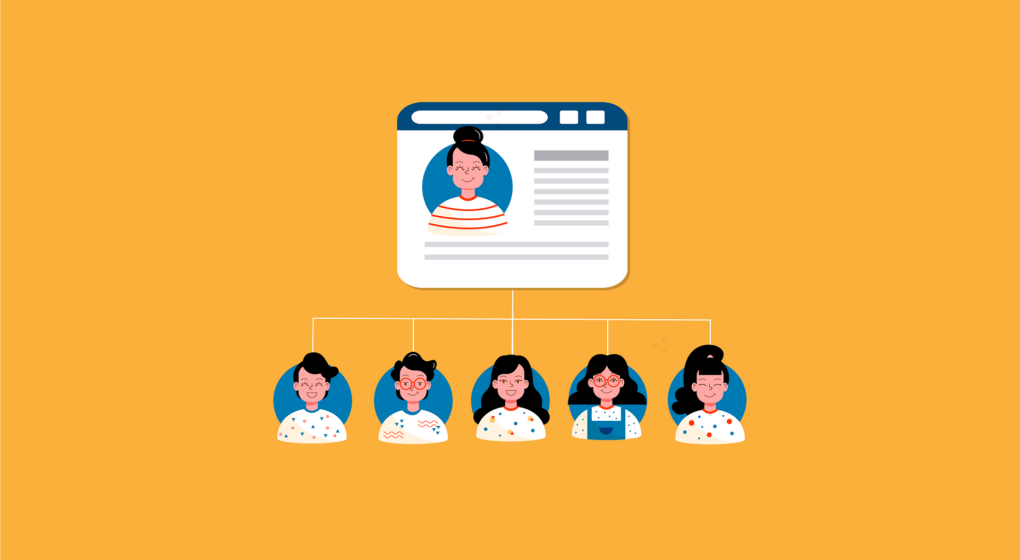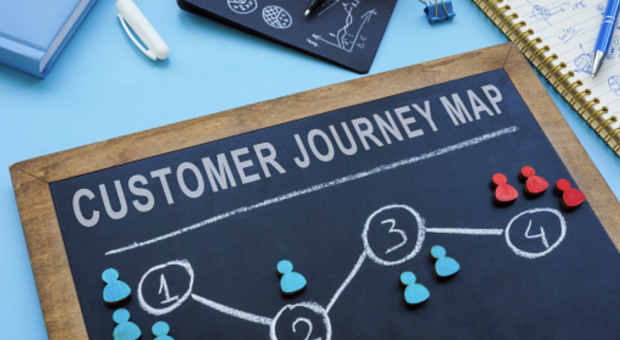
Let’s set the stage: You and your team are working on updating your website, content, and brand messaging. In this work, you will outline your ideal customers and discuss what messaging will best convey the advantages of choosing your product or services to them. It’s likely that you’ll use existing knowledge of your customers to make some educated guesses about what types of content will resonate with them and how they might interact with your brand. Chances are, the resulting picture of your audience will be accurate on some level, but it will also include inherent biases because it’s coming from your perspective instead of your customer’s.
Fortunately, there are many ways to analyze customer behavior more directly (and accurately) using data from sources like Google Analytics, marketing CRMs, and social media platforms, as well as digital reviews and customer feedback surveys. So, how do you combine your honed, colloquial/general customer knowledge and this hard data sourced from reliable tools? The answer is customer personas- and when you utilize these, we can ensure that your brand will create a more accurate and detailed audience model to inform your marketing efforts. Let’s dive in.
What are Customer Personas?
Customer personas are a great way to get a better idea of who your audience is and what makes them tick. Essentially, they’re fictional representations of your key audience, and they provide you with everything from basic demographic information drawn from data points, to relevant activities, hobbies, and habits for the audience. Additionally, they explore what kinds of content and which messages are most likely to capture and hold a prospect’s attention.
So, how do you go about creating and using customer personas? We’ll show you how, step by step.
Step 1: Set Customer Persona Goals
Firstly, ask yourself “why am I doing this?” Customer personas take time to develop and you will need to continue building them long term – so, it’s important to make sure you go into this exercise with a clear idea of what you would like to accomplish with them. For example, are you trying to improve or target your messaging? Are you trying to create better content that resonates with your audience? Are you redesigning your website and want to have a better idea of what will appeal to your audience? Or, are you doing something larger in scale like mapping and optimizing the customer journey?
Give some deep thought to your intentions behind this persona development exercise, get feedback from other key marketing stakeholders in your business, and then record your final goals and objectives. This will make it clear what you’re trying to achieve and how the personas you’re investing in will be used.
Step 2: Gather Customer Data Points
As a digital marketer, you understand the importance of having plenty of data points to look at when analyzing the efficacy of your marketing efforts. These data points are going to be important for creating your customer personas as well. Before you dive into brainstorming your personas, gather and organize your data so that it will be easy to read and assess, and then ensure you have everything you need to get a solid picture of your customers. This will require looking beyond the perceptions you hold about your customers and really drilling into data to discover what makes them tick. You can do that by utilizing:
- Google Analytics – At the very least, you’ll need to set up Google Analytics for your business’s website. Google Analytics can give you general information about your website and it’s audience, such as how many visitors are coming to your site and how long they’re spending on certain pages. But, it can also tell you more specific information about visitors, such as their average age, gender, interests, the types of devices they’re using, their progress (user flow) through the pages of your websites, and what channels brought them to you. So, take a good hard look at what your Google Analytics Data says about your audience and begin to separate it into distinct buckets so that it’s easy to analyze. For example, you may choose to separate things out by age group or gender, or perhaps by mobile vs. desktop users or interest groups. These buckets won’t necessarily end up being your end personas, but they’ll at least help you start thinking about the differences between members of your audience,
- CRM Data – If you have a CRM (customer relationship management system) such as Hubspot, Sharpspring, or Marketo, you’ll want to pull data from that as well. If you’re already using email marketing via your CRM, you’ll want to look at your open rates and click through rates, as well as taking an especially hard look at what CTAs (calls-to-action) seem to generate the most clicks and actions. If you are using segmentation for your email marketing program, meaning that you are targeting specific segments of your audience with your emails, then you’ll have even more of an idea of what age groups (as a rough example) are interacting with specific pieces of content within your emails. Furthermore, depending on your CRM, you may also be able to analyze specific data about the efficacy of your landing pages, lead capture forms, social media pages, and more. More robust CRMs such as Hubspot can help you track users as they interact with certain parts of your website, understand their engagement, and ultimately give you a more holistic view of your audience beyond email data.
- Customer Feedback Surveys – Customer feedback surveys are some of the most valuable representations of your customers’ overall experience with your brand. While Google Analytics and CRM data are valuable, there is still nothing better than directly asking your audience how they feel as they wind their way through the customer journey. If you haven’t collected any specific feedback from your customers prior to starting your persona development exercise, we strongly encourage you to do so. While you may not be able to gather as wide a swath of data from surveys as you can get from your CRM or Google, it will still be “straight from the horse’s mouth” and will allow you to hear your customers’ thoughts in their own voices.
- Colloquial Feedback from Employees – Colloquial feedback is feedback you collect from conversations with the employees who interact with your customers regularly. Even though this feedback isn’t coming directly from your customers, your salespeople and customer service representatives, etc., will know quite a bit about the customer experience, customers’ similarities and differences, and their motivations and goals. To gather colloquial feedback, you could create and deploy a survey or questionnaire to your employees, or talk to them directly and take notes.
- Social Media Analytics – if you use social media for your brand, it can tell you a lot about your audience and their interests. Social media platforms such as Facebook or Instagram can tell you how many impressions your posts are receiving as well as basic demographic information about your audience and how they’re engaging with your social media content. This is all valuable information when it comes to delineating and then creating accurate customer personas.
When you’ve collected and organized your data, it may be helpful to write up some summaries of the trends you’re seeing, as this will make it easier for you and your team to start brainstorming your different personas using key data points.
Data collection is definitely the most important part of creating your customer personas, but don’t worry if you don’t have data from all the channels we listed above. Customer personas are malleable by definition. What’s accurate for your business right now might not be in three years. So, say you start this process using only Google Analytics and colloquial data from your employees. You should still have a really decent picture of your audience segments that you can build on over time using more data collection tools. A general rule of thumb about customer personas is that something is better than nothing, and the more data you have, the more accurate your results will be. So, if necessary, start small and then try to build from there.
Step 3: Create a Customer Persona Questionnaire and Worksheet
Once you’ve pulled and organized your data, start building your customer persona questionnaire and worksheet. A great place to start is by thinking about what audience behaviors you want to know more about as they relate to your business, and think about what factors most influence the way people interact with content, such as device usage, demographics, interests, hobbies, etc. Then, build questions around these things. Keep in mind that you’ll be sharing this worksheet with your key marketing and sales stakeholders, so also think about the various types of information they could contribute to your customer personas and include some specific questions for them. Here are some sample questions we put on customer persona worksheets:
- What does this person do for work?
- What is their income level?
- What are their primary interests and hobbies?
- How technically fluent are they?
- From what sources do they get their news?
- What problems are they trying to solve?
- What are their primary motivators (i.e. what gets them out of bed in the mornings)?
You can also include questions that relate to your business specifically, such as:
- How did this customer find out about your business?
- What channel did they likely come into your funnel from?
- What types of messages are most likely to resonate with this customer?
- If you could share only one key, specific message with this customer, what would it be?
Remember to write up your questions so that you will get all the information you’ll need to achieve your goals for the persona exercise, but be open and prepared to adjust if the conversation during the customer persona workshop varies a bit.
Step 4: Organize and Conduct a Customer Persona Development Workshop
Now, for the fun part…get a customer persona workshop on the books! Include your key marketing and sales stakeholders and send them your persona development questionnaire prior to the workshop so they have some time to think about your questions ahead of time. To keep engagement high during the meeting, consider assigning someone to take notes while you facilitate the questions and help brainstorm on a whiteboard. However, if you’re like us and you’re working remotely or hybrid due to the pandemic, you might want to use a simple note taking or whiteboard collaboration app like Figma Jam shared on your screen to simulate brainstorming on a whiteboard. We also like to record all our customer persona workshops on Zoom to make sure we don’t miss anything!
We usually start our workshops by looking at our data summaries and identifying any similarities, differences, and trends we see within the data. Ask yourselves if there are any audience pools that you can clearly identify, or if there are key people within your audience that you want to speak to in particular. Once you’ve identified these audience buckets (a.k.a. the foundations of your customer personas), give them names. Giving them names will help you and your team keep track of them and envision them as real people rather than data points – think College Professor Carl, Businessman Bob, Retiree Rachel, Professional Peter, or Student Sarah. We typically recommend starting with 3-4 personas- any more than that and things can get too complicated.
Once you’ve got your personas named, start diving into your questionnaire with the group. Tackle the same or similar questions for each persona, recording everything from their basic demographics to information that’s more specific to their experience with your brand. Use your data during the discussion, too. This will take some time, so keep things fun and captivating if you’re running this as a marathon workshop meeting, or perhaps schedule separate, shorter workshops specific to each persona. It’s really up to you and your team.
Step 5: Create Your Customer Personas
Finally, after you’ve gotten all your questions answered and your notes compiled from your workshop(s), you can start creating your customer persona profiles. Create a customer persona profile or outline that includes similar categories from your questionnaire, such as their demographics, hobbies and interests, goals, motivations, frustrations, and key targeted messages. Then start plugging all the information you collected in your questionnaire into these categories.
At the most basic level, you can simply create an Excel spreadsheet for each persona and organize it based on information types. However, we also really like Figma Jam for it’s customer persona profile templates. You can also use this handy free tool from Hubspot or this template from Hootsuite to make things easier. The end result should be organized, concise, and easily readable persona profiles that you and anyone on your team can use to guide your content and branding efforts.
Putting Your Customer Personas to Good Use
So, there you have it! You’ve identified goals, pulled your data, created targeted questions, conducted a workshop, and created your final customer persona profiles. Now it’s time to put them to work. You can use your personas to:
- Learn more about your target audience
- Create targeted content that appeals to these specific personas
- Refine your brand messaging.
- Map your customers’ journeys and optimize them.
- Train your salesforce to respond to your customers in ways that will appeal to them.
- Understand how customers interact with your brand.
If the overall customer journey is the backbone of a solid inbound marketing strategy, customer personas are the brain. Everything begins there. Customers consume content, make certain decisions, and take certain actions depending on many factors, and customer personas are vital in helping you determine what those factors are and how you should respond to them so that your interactions with your customers are as productive as possible.
If you’re interested in creating customer personas, but you’re having trouble identifying goals for them, or if the whole process is simply too daunting, don’t forget that our inbound marketing team at VONT loves to dive in and help out with customer persona creation. Be sure to drop us a line if you want to learn more.
And, if you’re curious about the advantages of inbound marketing and what those could mean for your business, check out the first article in this inbound marketing blog series – Everything You Ever Wanted to Know About Inbound Marketing – Why Inbound?
About VONT Performance Digital Marketing
At VONT we believe that change is the only constant in the digital world – and that excites us. When tools and environments are constantly changing, new opportunities to help our clients achieve success are constantly arising. Each new advertising technology, social platform, or design approach allows us to improve on the results we achieve for our clients.We believe in this idea of continual fine-tuning so much that we named our company VONT, which means to achieve exponential improvement in incremental steps. It is our core belief, and the reason why we are not simply a web design company or simply a digital advertising agency, but rather a long-term, single source partner providing a comprehensive array of web development and digital marketing capabilities.


